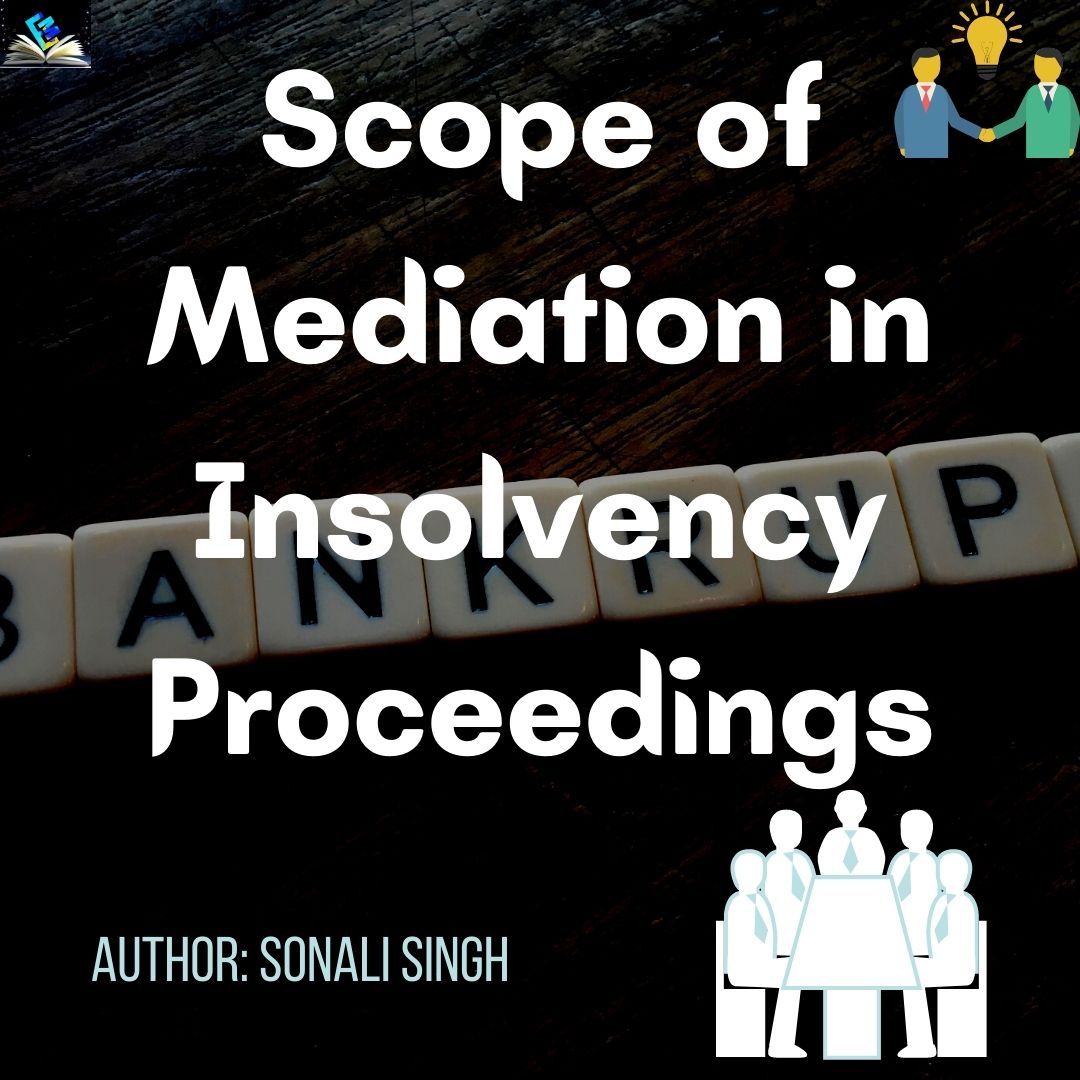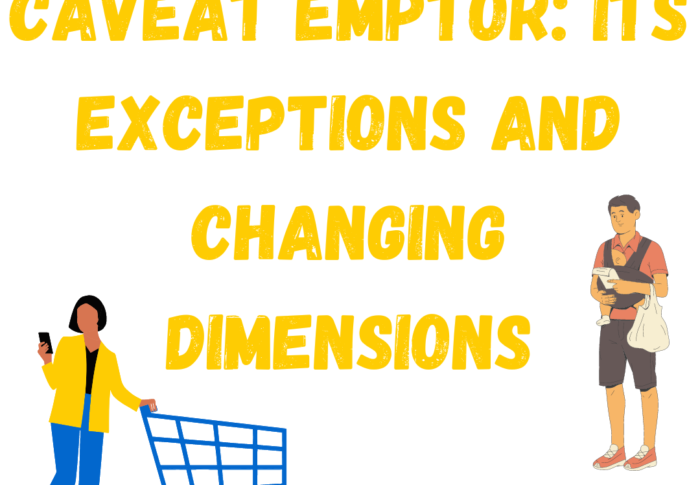
Scope of Mediation in Insolvency Proceedings
Keywords:- Mediation, Insolvency and Bankruptcy, IBC
Author: Sonali Singh
Mediation, according to BLACK’s legal dictionary, is a non-binding conflict settlement approach employing a neutral third person who attempts to assist disputing parties in reaching a mutually accepted solution. However, using a mediator to reach an agreement is a novel addition to the corporate insolvency resolution procedure.
Insolvency and Bankruptcy Code
The Insolvency and Bankruptcy Code of 2016, (IBC) was enacted to protect creditors’ rights to the timely payment of their debts and to reduce non-performing assets. This Act empowers creditors to seize control of debtor corporations and devise a resolution plan for the company’s reorganisation and rebirth. On behalf of the creditors, the insolvency experts authorised under the Code assume control of the company, its management, and its assets. This is a time-limited process that is estimated to take 180 days to complete, with a maximum extension of 90 days.
Mediation is an essential kind of alternative dispute resolution. It’s a private, voluntary process in which parties interact and negotiate with the help of a neutral third-party mediator. It is a cost-effective and quick procedure. It’s a method that allows all stakeholders to directly participate in the process.
Three objectives of insolvency mediation:
- resolution of the plan and bankruptcy-related disputes;
- facilitation of negotiations on a restructuring plan;
- prevention of insolvency.
Scope for Reform under IBC
Firstly, insolvency mediation can be used to resolve disputes for individuals and partnership firms. In cases of personal insolvency, court proceedings help in managing repayment and availing discharge under the Code. However, this process alone may not adequately achieve the aim of personal insolvency rehabilitating the debtor and avoiding repeated insolvency.
The Insolvency and Bankruptcy Board of India (IBBI) Working Group on Individual Insolvency recommended mediation for personal insolvency as “the majority of insolvency and bankruptcy proceedings involving individuals may not involve contentious issues, voluminous stakeholders, and high amount of debt or disputes justifying adjudication by authorities such as the Debt Recovery Tribunals (DRT). Following this recommendation, the Code can be suitably amended to allow for court-ordered informal and out-of-court mediated settlements in individual insolvency cases.
Secondly, through multi-party negotiations, mediation can be utilised to aid the collective settlement of several creditors’ claims against the corporate debtor company. In this case, mediation could be initiated by the creditors’ committee and the bankruptcy resolution expert. As previously stated, this would aid in the formulation of a holistic resolution strategy that takes into account the shared interests of all stakeholders.
Finally, due to the fact that the IBC is a new law and mediation in the country is still in its early-stages. Court-ordered mediation on a case-by-case basis will be more suited for all sorts of insolvency cases than required pre-litigation mediation. In this case, judicial guidance on when insolvency mediation should be initiated is required. These provisions should meet the Code’s requirement that insolvency matters be referred to mediation by the courts. These can be made based on a set of standards for income, assets, and debt.
Mediation
Mediation is a type of ADR in which a neutral third party strives to assist disputing parties in reaching an amicable settlement and a mutually acceptable agreement. It is a type of Alternative Dispute Resolution that has been given legal standing in India.
The Insolvency & Bankruptcy Code governs insolvency processes in the country, and it has proven to be effective in helping lenders recover their funds. Despite its strong recovery rate, it has produced a persistent fear of persecution among businesses, particularly small and medium-sized businesses (SMEs). Under normal circumstances, corporate insolvency should take 270 days to complete from start to end. However, because of the large backlog of cases that overburdens the National Firm Law Tribunal, and the time-consuming process of choosing whether to liquidate the company or adopt a resolution plan, the pendency in most cases exceeds a year.
What happens if the parties reach an agreement?
Mediation is successful when all the parties reach an agreement. The parties sign a “mediation settlement agreement.” The bankrupt will be required to comply with all conditions of the agreement.
What happens if the parties cannot agree?
Surplus income mediation
If mediation fails, the Licensed Insolvency Trustee (LIT) may apply to the court to fix, by order, the amount the bankrupt is required to pay the bankruptcy estate.
Discharge mediation
If mediation fails or the bankrupt does not comply with the conditions of the mediation settlement agreement, the LIT asks the court for a hearing to decide the matter
HIGH COURTS
The Calcutta High Court concluded in Gouri Prasad Goenka v. State Bank of India that the moratorium provided by Section 14 of the Code does not prevent a wilful defaulter declaration proceeding. This refers to the dissemination of credit information about wilful defaulters in order to alert banks and financial institutions so that no further bank finance is made available to them. Rather than for the recovery of the corporate debtor’s debts or assets, which could stymie the insolvency resolution process (CIRP). The High Court further stated that an act of intentional default done by a promoter/whole-time director/guarantor of the corporate debtor who was in charge at the time is not automatically wiped out by the statute of limitations.
NATIONAL COMPANY LAW APPELLATE TRIBUNALS
In Mr. Rakesh Kumar Agarwal and Others v. Mr. Devendra P. Jain, the National Company Law Appellate Tribunal (NCLAT) of New Delhi held that the government notification dated June 1, 2020. Concerning changes to the classification of micro, small and medium enterprises (MSME) under the Micro, Small and Medium Enterprises Development Act, 2006, will apply to corporate debtors whose liquidation process was still pending under the Code. The NCLAT in New Delhi overturned an adjudicating authority’s decision that the notification was inapplicable to corporate debtors. As it went into effect at a later date while reiterating that the Code’s main goal is to resolve insolvency and that liquidation of a corporate debtor is only a last resort.
In Jayanta Banerjee v. Shashi Agarwal Liquidator of INCAB Industries Ltd and Ors. the NCLAT in New Delhi decided that the term ‘collation’ under Section 21(1) of the Code. It refers to the verification of creditors’ claims, or the comparison of a copy with its original to verify its validity. According to the NCLAT in New Delhi, a meeting of the committee of the creditors (CoC) cannot be held without the verification and admission of the creditors’ claims, followed by the assignment of voting shares to such creditors.
Conclusion
Mediation is viewed as a more efficient, quick, and cost-effective alternative to going to court to resolve a disagreement. Several initiatives have been made to promote the use of insolvency mediation in practise and legislation, particularly in pre-insolvency procedures without the involvement of an insolvency practitioner. Although research is currently limited, the Dutch pilot on insolvency mediation has shown promise. In this case, views from the United States could be useful. Given their success in creating a professional and seasoned practise.
Mail us at edumoundofficial@gmail.com






